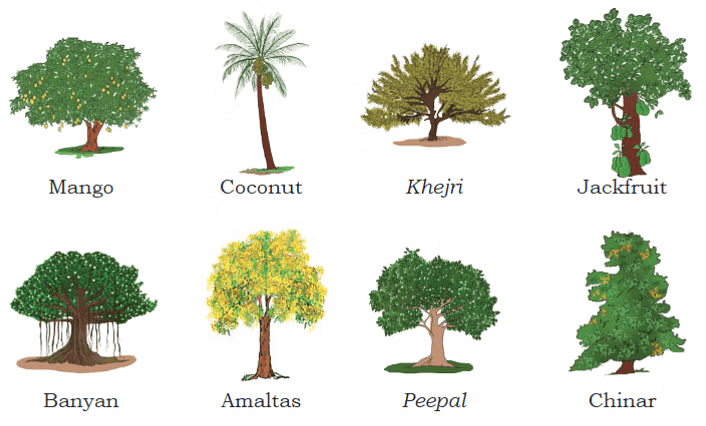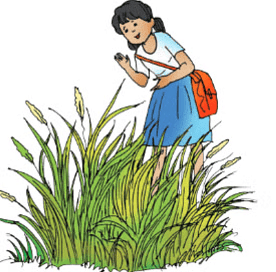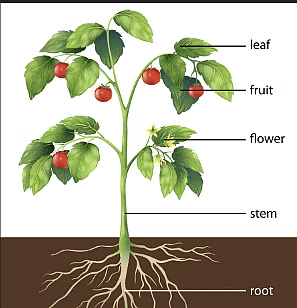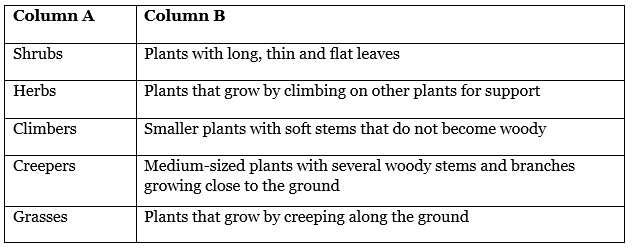Worksheet Solutions: Getting to Know Plants | Worksheets with solutions for Class 3 PDF Download
| Table of contents |

|
| Fill in the Blanks |

|
| True or False |

|
| One-Word Answer Type Questions |

|
| Multiple Choice Questions (MCQs) |

|
| Match the Following |

|
Fill in the Blanks
Q1: _______ are the largest plants with thick trunks and many branches.
Ans: Trees
Trees are the largest plants with thick trunks and many branches.
Q2: Shrubs have many _______ stems that grow close to the ground.
Ans: Woody
Shrubs have many woody stems that grow close to the ground.
Q3: Herbs have _______ stems that do not become woody.
Ans: Soft
Herbs have soft stems that do not become woody.
Q4: Grasses have long, thin _______ and hollow stems.
Ans: Leaves
Grasses have long, thin leaves and hollow stems.
Q5: Climbers grow by _______ on other plants or structures for support.
Ans: Climbing
Climbers grow by climbing on other plants or structures for support. 
True or False
Q1: Trees have a single main trunk that is woody.
Ans: True
Trees have a single main trunk that is woody.
Q2: Herbs have thick, woody stems like shrubs.
Ans: False
Herbs have soft, green stems that do not become woody.
Q3: Climbers and creepers both have thick, hard stems.
Ans: False
Climbers and creepers have thin and flexible stems.
Q4: Leaves of different plants can have different smells.
Ans: True
Leaves of different plants have unique smells.
Q5: The pumpkin plant is an example of a climber.
Ans: False
The pumpkin plant is an example of a creeper. 
One-Word Answer Type Questions
Q1: What part of the plant helps absorb water and nutrients from the soil?
Ans: Roots
Q2: Which part of the plant is responsible for producing food?
Ans: Leaves
Q3: Name a plant that grows by creeping along the ground.
Ans: Pumpkin
Q4: What is the hard outer covering of a tree trunk called?
Ans: Bark
Q5: Which plant part contains seeds and helps in their dispersal?
Ans: Fruits 
Multiple Choice Questions (MCQs)
Q1: Which of the following plants has soft, green stems?
(a) Trees
(b) Shrubs
(c) Herbs
(d) Creepers
Ans: (c) Herbs
Herbs have soft, green stems that do not become woody.
Q2: What are climbers known for?
(a) Spreading on the ground
(b) Climbing on other plants or supports
(c) Growing straight and tall
(d) Having deep roots
Ans: (b) Climbing on other plants or supports
Climbers grow by attaching themselves to other plants or structures for support.
Q3: Which of these is an example of a shrub?
(a) Mango tree
(b) Tulsi plant
(c) Grass
(d) Pumpkin
Ans: (b) Tulsi plant
The tulsi plant is a shrub with multiple woody stems.
Q4: What kind of stems do creepers have?
(a) Thick and strong
(b) Thin and flexible
(c) Soft and green
(d) Hollow
Ans: (b) Thin and flexible
Creepers have thin and flexible stems that spread along the ground.
Q5: Which plant part performs photosynthesis?
(a) Roots
(b) Stems
(c) Leaves
(d) Flowers
Ans: (c) Leaves
Leaves perform photosynthesis to produce food for the plant. 
Match the Following

Ans:
Shrubs: Medium-sized plants with several woody stems and branches growing close to the ground
Herbs: Smaller plants with soft stems that do not become woody
Climbers: Plants that grow by climbing on other plants for support
Creepers: Plants that grow by creeping along the ground
Grasses: Plants with long, thin and flat leaves
FAQs on Worksheet Solutions: Getting to Know Plants - Worksheets with solutions for Class 3
| 1. What are the main parts of a plant? |  |
| 2. How do plants make their food? |  |
| 3. Why are roots important for plants? |  |
| 4. What is the role of leaves in a plant? |  |
| 5. How do flowers help plants reproduce? |  |















